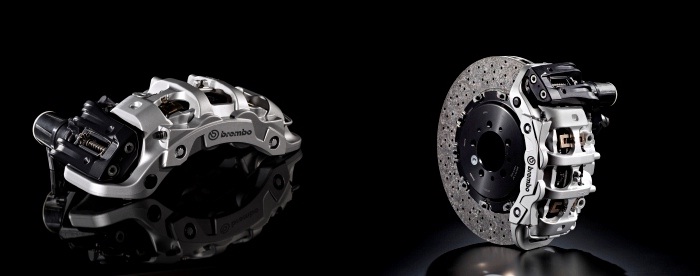Designed especially for a sports car — the successor to the Ferrari Enzo — the new “Extrema” Brembo caliper features an innovative design and reduced weight and mechatronics.

Brembo supplies the whole braking system on the new special limited edition of the Ferrari. This is the Maranello-based manufacturer’s first car to be fitted with the hybrid HY-KERS technology that associates the V12 power unit, delivering up to 800 HP, with a 120 kW electric motor that recovers the energy produced while braking, also thanks to the experience gained on the F1 tracks with the Ferrari KERS system. The “Extrema” Brembo caliper is designed for high end cars with a strong sporting vocation. In short, a product designed to meet the requirements of an extremely demanding and continuously evolving market.
New design with improved performance
The new “Extrema” Brembo caliper has distinctive traits that derives from a more minimalist approach in design, appearing decidedly more exposed and hollowed out than its predecessors. An aggressive and innovative look that translates, first and foremost, into a significant reduction (more than 3 kg) of non-suspended weight and a better feel through the pedal, with less power absorbed than hitherto (10% reduction).The newly designed caliper also improves ventilation, with the result that brake fluid temperature is reduced by more than 30 °C. This aspect of performance has been verified by thorough-going tests conducted on the Ferrari test track at Fiorano.Whilst the front wheels have a six piston caliper, and the rear wheels a four piston type incorporating the electric parking brake, the two calipers are visually identical. Viewed from the side, in effect, there is no discernible difference.
The advantages of mechatronics
For the first time, in the new “Extrema” Brembo caliper, the electric parking brake is incorporated directly in the caliper.Thanks to mechatronics, which enables a close interrelation between different disciplines — mechanics, electronics, IT —, Brembo has produced an electronic control unit and control software that manages the parking brake.
Brembo calipers to the fore
The new “Extrema” caliper derives directly from the involvement of Brembo in Formula 1.
- Given the high loads generated by the pressure of the pistons on the pads, maximum stiffness and minimal deformation are assured by adopting a monobloc design, in other words the caliper body is machined from a single billet of cast aluminum.
- The front calipers are equipped with six pistons specified with dissimilar diameters to ensure uniform wear on the pads, which otherwise would deteriorate more quickly on the disc entry side.
- The rear calipers have four pistons with dissimilar diameters. The pistons are equipped with heat shims and drilled radially around the circumference engaging the pad, in order to attenuate the transmission of friction heat to the brake fluid in the hydraulic system.
- The brake pads are made by Brembo; the friction material is a mixture of specifically measured organic elements, guaranteeing the best possible braking performance with Brembo CCM brake discs, made from a ceramic compound.
- Launched in 2002 on the Ferrari Enzo, Brembo CCM discs weigh over 50% less than cast iron discs. This advantage drastically reduces the unsprung weight of the vehicle, which in turn ensures exceptional dynamic behavior and excellent driving comfort.
Reduced braking distance
In order to evaluate the performance of a car, it isn’t enough simply to look at how many seconds it take to go from 0 to 100 km/h. the other side of the coin has to do with braking performance. A German magazine called Auto Motor Und Sport created a ranking system for it which, thanks to a scientific method and precision instruments, took all of the best cars in the world onto the track and measured the distance each one needed to go from 100 km/h to 0 km/h. The picture below shows a status in 2008.
Source: Brembo
Romain’s opinion:
This caliper technology seems obvious as it provides a good heat evacuation and a reduction of the non-suspended mass. However it might be expensive as it is provided only for supercars so far. Do you think the extra cost can be compensated by the fuel savings due to weight reduction for mass production cars?




















